Labradors are kind and affectionate companions. Consistently ranked on top, they are America’s 2nd most popular dog breeds. Labs are easy to train and are a fast-growing breed. So when do labs stop growing? They become adults after 6 months. But they grow right up to 2 years of age.
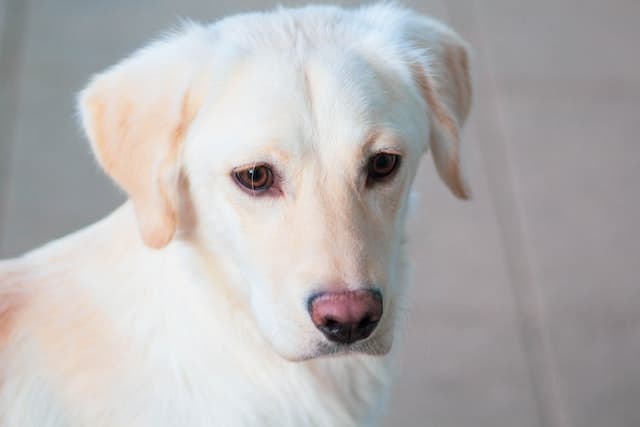
What Is The average Labrador adult size?
According to the American Kennel Club Official Labrador Retriever Breed Standards, a fully-grown lab weighs between 60 and 80 pounds. It stands between 22 and 24.5 inches tall in height.
- The average weight of an adult size female lab is between 55 to 70 pounds.
- An average height is 21.5 to 23.5 inches.
- Dog’s growth rate reflects its athleticism and muscles.
How To Ensure That Your Lab Is Healthy?
Like many dogs, purebred labs are prone to different health problems. Some common health scares are hip dysplasia, arthritis, skin issues, cancer, and others. They can also become obese if you don’t control their diet or they do not exercise much. It leads to joint disorders as well. Preventive pet care can be extremely beneficial. It will help your vet monitor their weight and growth rate regularly.
lab growth chart: Male And Female Stages Of Growth
This chart benefits all pet parents scratching their heads, wondering when labrador retrievers will stop growing. The chart is only a guideline, though. As a lab matures at around 10 months, they gain a lot of mass. The height remains the same.
labrador weight chart + height chart
Here’s the male labrador weight chart and height chart for reference.
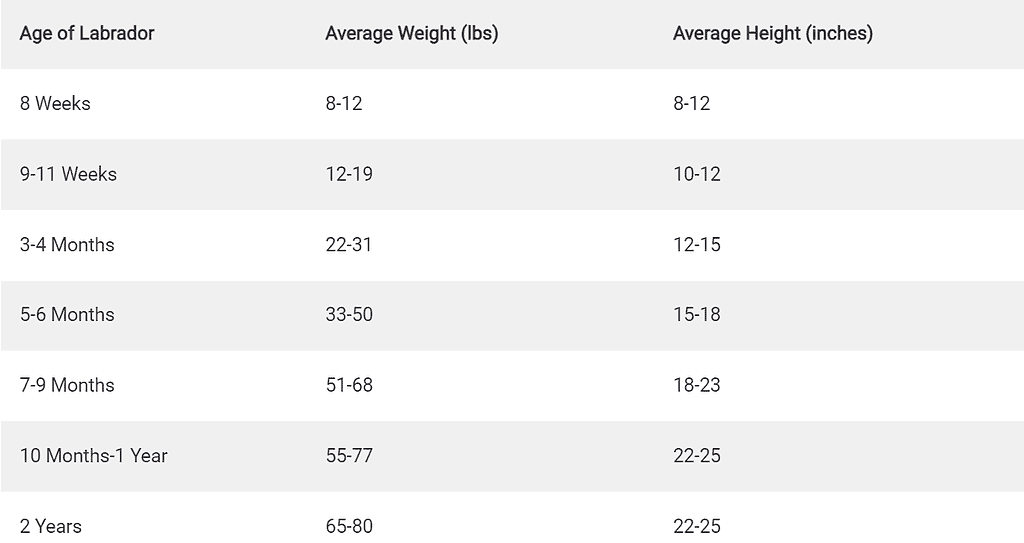
Female labrador retriever growth chart and height chart for reference.
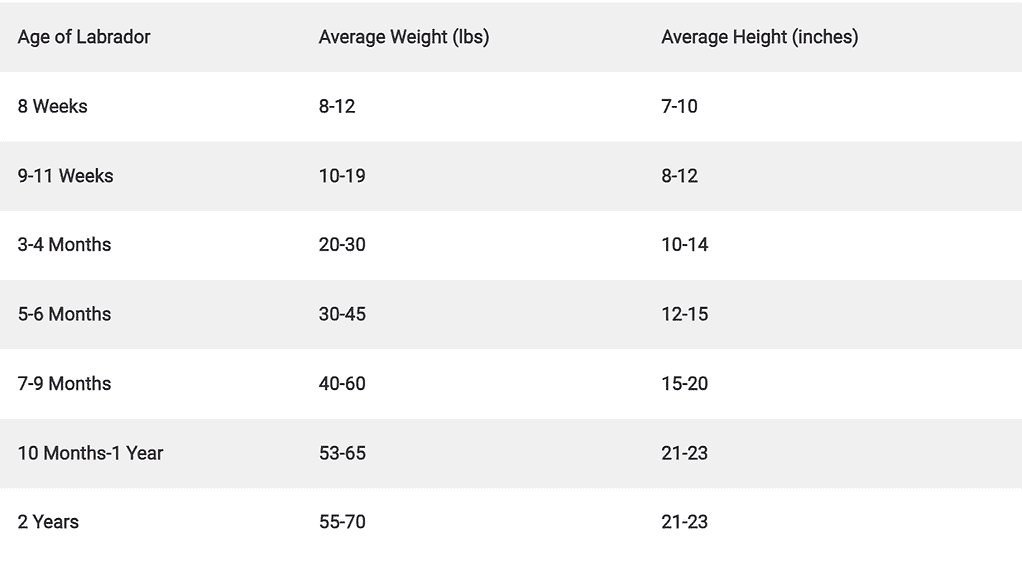
how long do labradors grow?
Most labs reach their full weight at 18 months and grow maximum between 9 and 12 months. Breeders opine that labrador retriever weight gain stops at some point before their second birthday.
Do not worry if your Labrador retriever puppy doesn’t reach an important milestone according to their growth patterns. It is common for pups to grow quicker or slower than the average. But if your lab is not gaining enough or gaining too quickly, then be cautious.
Working or hunting labs are usually smaller than average as they have less weight due to fieldwork. Their size can be genetic. If their parents were large dogs, they would also be massive. Other causes include overfeeding, less physical activity, or both.
Labrador head growth
Skeletal growth in a lab continues till nine months. After this, the growth is mostly the muscle mass. Most of their growth completes in the first year and then gradually increases until they are 18 months old.
Will my dog still grow after being neutered?
Neutering and spaying have minimal impact on the lab’s growth rate. In males, neutering calms the lab and relaxes, resulting in less physical activity and weight gain. Many studies show that labs that get neutered before 9 months are more likely to become obese. The difference is minimal; you shouldn’t worry too much.
when do english labs stop growing?
The two most common types of labs are English & American.
- English labs are much more muscular than American labs. They have a thicker and waterproof coat, whereas American Labradors have a lean build with a finer coat.
- English labs are shorter than American labs but much heavier. On average, English labs weigh 20 pounds more than American labs.
- American labs are more active and have more energy, whereas English labs are laid back but have sufficient energy.
labrador growth stages
You can use a labrador weight calculator to test your dog and see if he has the correct weight according to the labrador retriever weight chart.
The lab’s growth rate depends on different factors, including pre-birth and post-birth. The pre-birth factors are the dog’s genetics and uncontrollable factors. Post-birth factors are more under your control.
Food and Nutrition
Food and nutrition play an essential role in labs assuming full size. Get them a balanced diet to facilitate the dog’s growth. The focus should not only be on quality but also on quantity.
The Overall Health
The dog’s growth is also highly dependent on its overall health. Different health issues cause a significant impact on their growth. Worm infestation can slow down your lab’s growth.
Neutering or Spaying
Neutering and spaying remove sex hormones from the body, which regulate growth. It is more prevalent in dogs who get neutered or spayed early. You should wait for the right age before proceeding.
Does The Coat Color Affect The Growth?
Is it a question of color? The Labrador growth chart doesn’t change whether they are black or yellow. The average size of a chocolate lab will be similar to that of a yellow or a black lab.
Differences In Growth of Black and Grown Chocolate Labs
No concrete evidence suggests that black or chocolate labs grow at a different rate. Irrespective of their coat color, all labs grow at the same rate. They mostly stop growing at around 9 months. Later they continue filling up till they are 2 years old.
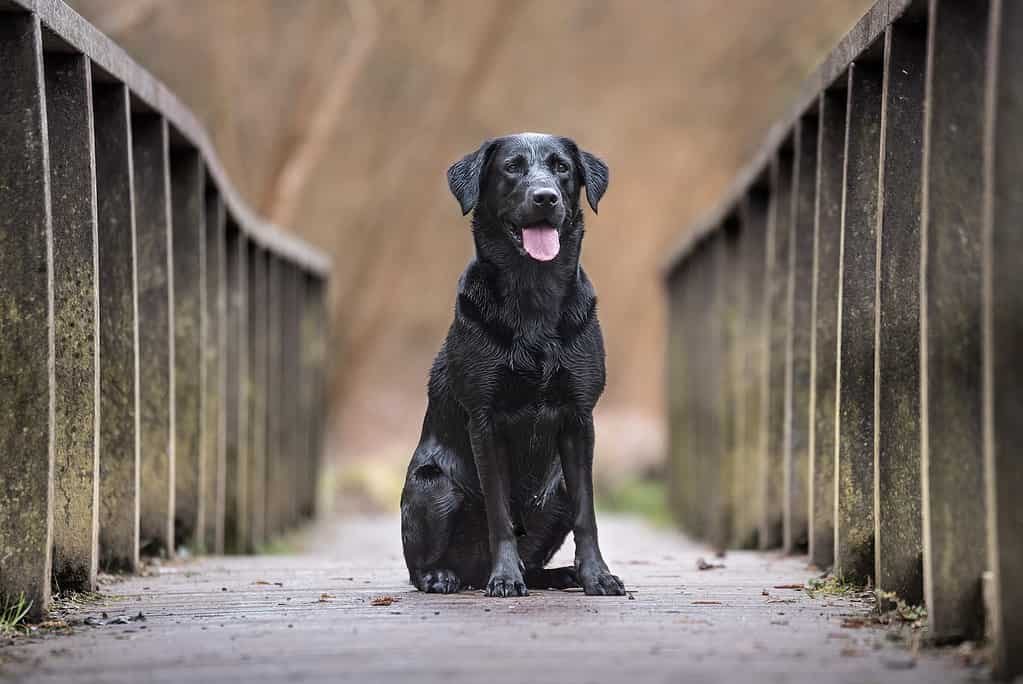
labrador puppy stages: Week By Week
First Two Weeks
- During their first week, labs grow rapidly.
- By the end of their first week, they are usually around two times their birth size.
- In the neonatal stage, puppies are entirely dependent on their mother.
- They need their mother to keep them warm.
- Pups are born without vision, teeth, or hearing abilities. Their mother does most work for them.
Till Week 8 ( 2 months old )
- After the initial week, the lab’s growth will slow down but continue growing.
- They will grow between 5-10% daily until the eighth week.
- Their eyes and ear will begin to open in the second week. The transitional phase begins when they start to respond to the outside world.
- The fourth week witnesses the awakening of the senses. They start becoming conscious and notice extreme changes or noise.
- Around the 7-week mark, the socialization period ends.
- Lab pups must be introduced to humans between 5 and 7-week periods.
- The 8th week is the second socialization phase of a labrador. You can begin basic training with gentleness. It is also the time for puppy training and vaccination.
- Knowing how much to feed a 2-month-old lab is essential. 4 small daily meals appear fine.
Week 12 To 16 ( 3-4 months old )
- Around this time, your lab will show another growth spurt where they will gain weight quickly. This spurt happens in female labradors around the 89th day from birth and the 95th day for male dogs.
- Juvenile stages begin from the 12th week.
- A 3-month-old puppy can avoid your commands. Playing games that convey it is alright to challenge authority must be avoided.
- A 4-month-old labrador retriever can be rebellious. Obedience training can help divert their attention.
- Their growth will again slow down after this phase. By the 18th week, you can expect your lab to attain half its full weight.
After Six Months Old
- The bone growth of your lab will stop at six months, meaning they won’t be taller. While they will continue gaining weight for 2 years, it will be slow.
- Adult face and coat begin to develop here onward.
- Desensitize them by being gentle and kind.
- A one-year-old labrador has attained sexual maturity.
- Most attain their actual size by this time. ( Watch out for stunted growth)
- They remain puppies mentally for 2-3 years. Old labrador retrievers are common, so don’t get surprised.
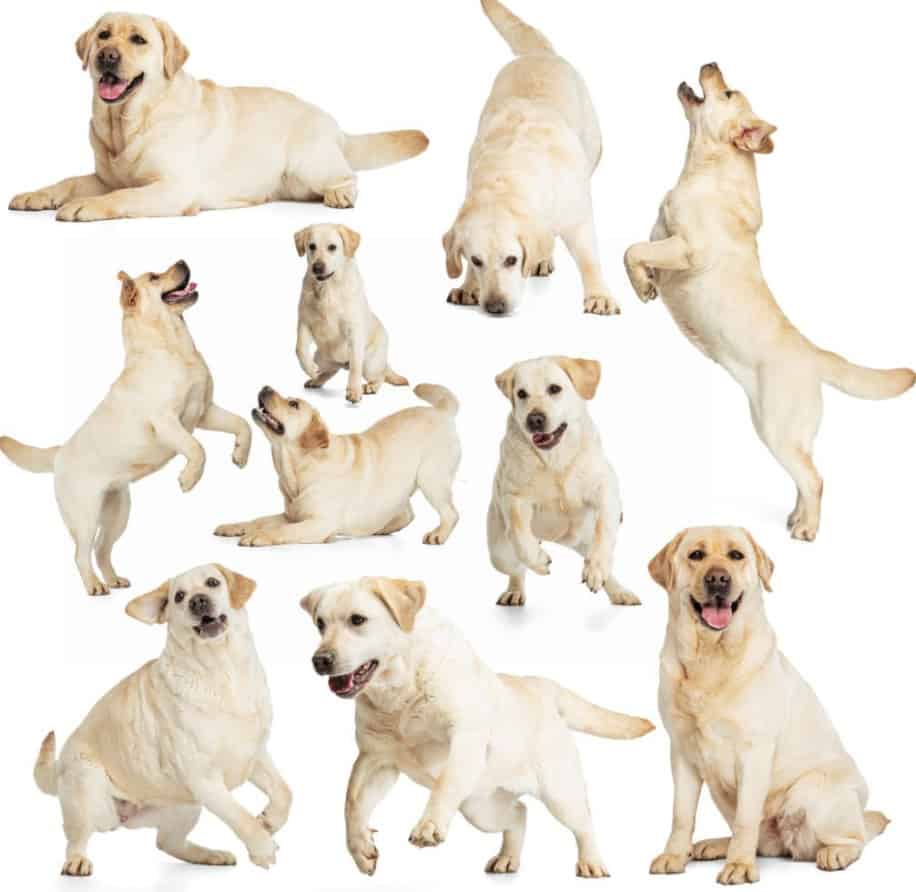
What Is The Ideal Weight A Lab Puppy Should Gain Per Week?
The best way to see if your puppy lab is growing is by tracking its weight weekly. A healthy puppy should add around 2 lbs every week till they are 6 months of age. After six months of age, your dog’s growth rate will decrease. It will start adding between 1-1.5 lbs every week. Tracking is a good attempt to prevent underweight dogs
how much food should a lab puppy eat?
Your dog should get nutrients from their mother’s milk in the first month. After this, you can introduce soft puppy food. As they cross eight weeks, please provide them with around two cups daily divided in 3-4 meals. At ten weeks, increase the quantity to 3 cups. As they cross 12 weeks, increase it to 4 cups daily.
What Is The Best Food For Your Lab?
Your Labrador puppy should get all the necessary nutrients and calories. Provide them with food that has natural, human-grade ingredients for sufficient proteins and vitamins. Royal Canine retriever food for puppies, and adult dogs are great for lab’s health.

Can you always predict size with a Labrador puppy?
It depends much on the lab parents. Knowing that your puppy’s parents have a healthy weight will give an idea of the labrador’s size. Like, English labrador retriever is heavier than their American counterpart. There can still be exceptions.
Do small pet parents affect Labrador’s growth?
Just like it is challenging to predict when the labrador will stop growing, it is the same for the size. The height and weight guidelines are broad, and you can only get a rough idea. Genetics plays a significant role. Small pet parents can result in smaller dogs than regular ones.
when does puppy growth slow down?
The growth chart of a puppy varies based on the lab type, parent’s size, appetite, and health. The below reasons can impact a puppy’s growth speed.
- Show line labrador retriever is heavier than the working stock.
- Small pet parents usually produce small lab puppies.
- If you feed them insufficiently or with the wrong diet, they will not grow properly.
- Puppies having a serious illness may not experience normal growth.
Genetics significantly impacts a lab’s size. Lab puppies with small parents might remain small for their age throughout. Pups from the same litter can also have variations in size.
Do neglected puppies grow slower?
Adverse environmental factors and improper care can interrupt a puppy’s growth. A stressed puppy will have a poor appetite, leading to slow growth. Neglected health results in adverse growth and must be avoided. Contact a vet and know your puppy’s health if in doubt.
Does it matter if my labrador retriever puppy is a bit plump?
Pet owners assume that puppy fat is good. An extra layer of fat is believed to sustain the puppy during illness. Today, the demand is for slim pups. Overfeeding not only makes your dog plumpy but also makes their bones grow faster. It leads to skeletal irregularities in later life. Assess how your dog looks and feels and act accordingly.

FAQs
When do labs calm down?
Labradors do not calm down till they cross the age of two. While few labs are quiet from birth, some remain bouncy until they are old. The mental and sexual maturity is seen after they complete two years.
Is A Labrador Fully Grown At 7 Months?
Labs come under the medium to large breed category. On average, they need around one year to reach their maximum size. The general rule suggests that your lab will be of its full size by its first birthday. But they will continue filling up even during the next 6-12 months.
how big do labs get fully grown?
If you want to know how long do labradors grow and their ideal weight, the average weight of a female lab is 55-75 lbs. They have a height of around 22 inches. An average male lab weighs 65-85 lbs and has a height of 23 inches.
My Lab Puppy Is Too Short What Can I Give Him To Make Him Tall?
Your lab’s growth depends on its genes and post-birth care. While you can take care of it after birth, you can do nothing about genes. Let your pup grow for a while as they continue growing till 18-24 months. Ensure that you provide them with the right nutrients.
Can I Increase My Labrador’s Head Size After 6 Months?
Labs grow rapidly in their first six months and continue growing for the next 12-18 months. Since the growth trajectory gets slower, you might not notice. There is little that you can do to increase the growth rate or control it.
What Temperature Would Be Best For My Labrador Dog?
Historically, labs are an athletic and hardworking breed with a double coat to protect against cold and water. Depending upon the thickness of their coat, the ideal temperature is around 90 degrees F with less than 20-30% humidity.
How Long Does A Labrador Retriever Take To Mature?
Labrador maturity age is at 2 years. It depends on the training you provide them over their growth years.
How much do Labs grow per week?
Labs ideally grow two pounds per week till they are six months. Then it will reduce to one and a half pounds till they are a year old.
What is the ideal lab weight ?
For female labs, the weight ranges from 49.4 lbs to 76.7 lbs. For a male lab, it is 63.3 lbs to 85.3 lbs. An average labrador retriever’s weight falls between 55 pounds and 80 pounds.
What is the 7 month old labrador size?
Labrador grows fully by their first birthday. They need 12 to 18 months for complete growth. A 7-month-old labrador retriever is usually 51-59 lbs in weight and 16-19 inches tall.
How do you tell how big your Lab will get?
Age, paw size, and genetics can be used to predict a labrador retriever’s size. While most labs grow big by 12 months old, some need up to 18 months.
Oversized paws mean the labrador retriever is in its puppy phase and will get bigger. Contact the breeder for the dog’s parent’s height and weight. It gives an idea of the puppy’s final size.
How much bigger will my lab at 6 months Be?
An average 6 months old male labrador is 40 to 55 pounds. The female labrador tends to be 30 to 35 pounds. These are average figures, and each puppy’s growth chart is unique.
Is a 2-year-old Lab still a puppy?
Yes, a 2-year-old can still be a puppy. Labrador retriever settles down between 2 and 4 years. They inhibit a puppy’s exuberance and energy till then.
At what age does a Labrador reach full height?
Labrador retriever is a fast-growing breed. The average adult labrador retriever reaches a full height between six and twelve months. Some labrador retrievers may grow up to two years.
when do labs stop growing in height?
Nine months. Labs grow quickly in their first year. Muscle growth is as critical as bone development.
How big will my yellow Lab get?
A male yellow labrador retriever grows 22.5-24.5 inches, and females stand 21.5-23.5 inches tall. They weigh between 55 and 80 pounds.
how big do yellow labs get? When Will They Grow Full?
A yellow labrador retriever grows at the same rate as a black lab. A yellow lab will grow full between six and twelve months.
How big should a yellow Lab be at 6 months?
A male yellow labrador retriever will grow about 40-50 lbs, and a female about 35-45 lbs. A female yellow labrador’s height tends to be 21.5 to 23.5 inches. A male yellow lab’s height is about 22.5 to 24.5 inches.
What is the ideal weight for a chocolate lab?
An ideal weight of a chocolate labrador retriever is between 55 pounds and 80. The actual weight varies depending on the sex and specific growth rate.
How much should a 1-year-old chocolate lab weigh?
A 1-year-old male chocolate labrador retriever is 65 to 80 lbs. And a female should weigh about 55 to 70 lbs. Each lab puppies are unique and have a distinct growth rate.
How much should a 1 year Labrador dog weigh?
A 1-year-old male labrador retriever weighs about 65 to 80 lbs. An average female labrador retriever weighs 55 to 70 lbs.
when do chocolate labs stop growing?
A chocolate lab is a popular dog breed with a fast growth rate. They reach adult weight and height between six and twelve months. A full-grown labrador retriever sometimes takes two years to complete the growth process.
How big should a 6 month old chocolate lab be?
Most labrador retriever puppies grow 2 pounds per week. As per the labrador retriever growth chart, a chocolate lab will weigh about 50 lbs when 6 months old.
How big will my chocolate Lab get?
The adult weight of a chocolate lab is about 55 to 80 pounds. Adult height is said to be between 21.5 and 24.5 inches. Actual chocolate labrador retriever’s growth depends on the dog’s body condition.
when do female labradors stop growing?
Female Labrador Retrievers stop growing between 12 and 15 months of age. However, some females may continue to grow until they are 18 months old.
when do male labs stop growing?
Male Labrador Retrievers stop growing between 18 and 24 months of age. However, some males may continue to grow until they are 36 months old.
When do English labs stop growing?
English Labrador Retrievers are a larger breed of Labrador Retriever, and they take longer to grow than their American counterparts. English labs stop growing between 18 and 24 months of age. However, some English labs may continue to grow until they are 36 months old.
When do dogs stop growing?
The age at which dogs stop growing varies depending on their breed. Small breeds stop growing between 6 and 8 months of age, while large breeds may not reach their full size until they are 18 to 24 months old.
| Breed | Average Age of Full Growth |
|---|---|
| Toy breeds | 6-8 months |
| Small breeds | 9-12 months |
| Medium breeds | 12-18 months |
| Large breeds | 18-24 months |
| Giant breeds | 24-36 months |
How Long Does It Take For A Lab To Be Fully Grown?
Labrador retrievers reach their full adult size at around 18-24 months of age. However, they will continue to fill out and mature until they are about 3 years old.
When Does A Black Lab Stop Growing?
Black labs stop growing at the same age as other labs, around 18-24 months. However, some black labs may take a little longer to reach their full size.
How Much To Feed A Lab Puppy By Weight?
The amount of food you should feed your lab puppy will vary depending on their weight, age, and activity level. As a general rule of thumb, you should feed your lab puppy about 2-3% of their body weight daily.
So, for example, if your lab puppy weighs 10 pounds, you should feed them about 2-3 ounces of food daily.
When Do Silver Labs Stop Growing?
Silver labs stop growing at the same age as other labs, around 18-24 months. However, some silver labs may take a little longer to reach their full size.
When Do Small Dogs Stop Growing?
Small dogs stop growing at around 12-18 months of age. However, some small dogs may take longer to reach their full size.
When Do Large Dogs Stop Growing?
Large dogs stop growing at around 18-24 months of age. However, some large dogs may take a little longer to reach their full size.
Author Profile
- Site Owner And Dog Lover
-
Aritra, the founder of Labradorandyou.com, is a lifelong dog lover whose passion ignited for Labradors for their loyalty and intelligence. With extensive research and personal experiences, Aritra has become a Labrador expert, offering a rich resource on the breed. Labradorandyou.com provides reliable, timely, and evidence-based information, including Labrador-specific product reviews, training techniques, and care tips.
Labradorandyou.com was born out of Aritra's passion and his desire to share his profound knowledge about the breed. The site serves as a comprehensive resource, offering a wealth of up-to-date information for Labrador owners and enthusiasts alike
Also by the author
-
 Lab-TypesNovember 17, 2023Old Dog Seizures: Causes, Symptoms, and Treatment Options
Lab-TypesNovember 17, 2023Old Dog Seizures: Causes, Symptoms, and Treatment Options
-
 Lab-TypesNovember 17, 2023Why Is My Dogs Poop Yellow? 8 Reasons & Solutions
Lab-TypesNovember 17, 2023Why Is My Dogs Poop Yellow? 8 Reasons & Solutions
-
 ReviewsNovember 17, 2023The Only Hill’s Science Diet Review You Need To Read
ReviewsNovember 17, 2023The Only Hill’s Science Diet Review You Need To Read
-
 Lab-TypesNovember 17, 2023How To Adopt An Emotional Support Dog?
Lab-TypesNovember 17, 2023How To Adopt An Emotional Support Dog?





